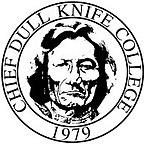
The Cheyenne are an Indigenous people of the Great Plains. Their Cheyenne language belongs to the Algonquian language family. Today, the Cheyenne people are split into two federally recognized nations: the Southern Cheyenne, who are enrolled in the Cheyenne and Arapaho Tribes in Oklahoma, and the Northern Cheyenne, who are enrolled in the Northern Cheyenne Tribe of the Northern Cheyenne Indian Reservation in Montana.
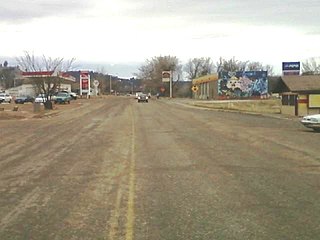
Lame Deer is a census-designated place (CDP) in Rosebud County, Montana, United States. The community is named after Miniconjou Lakota chief Lame Deer, who was killed by the U.S. Army in 1877 under a flag of truce south of the town. It was the site of a trading post from the late 1870s.

The Cheyenne language, is the Native American language spoken by the Cheyenne people, predominantly in present-day Montana and Oklahoma, in the United States. It is part of the Algonquian language family. Like all other Algonquian languages, it has complex agglutinative polysynthetic morphology. This language is considered endangered, at different levels, in both states.

Iḷisaġvik College is a public tribal land-grant community college in Utqiaġvik, Alaska. Operated by the North Slope Borough, a home rule government of the Iñupiat, it is the only tribally controlled college in Alaska, and it is the northernmost accredited community college in the United States. The college is located within the boundaries of the North Slope. It is an 89,000-square-mile (230,000 km2) region of Arctic tundra. It is connected to the 414-mile (666 km) Dalton Highway only during the winter, by an ice road for local residents. The community can also be reached by plane.
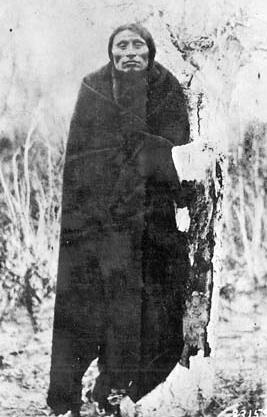
Little Wolf was a Northern Só'taeo'o Chief and Sweet Medicine Chief of the Northern Cheyenne. He was known as a great military tactician and led a dramatic escape from confinement in Oklahoma back to the Northern Cheyenne homeland in 1878, known as the Northern Cheyenne Exodus.
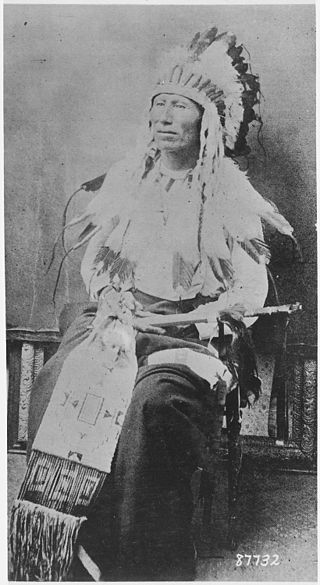
Morning Star was a great chief of the Northern Cheyenne people and headchief of the Notameohmésêhese band on the northern Great Plains during the 19th century. He was noted for his active resistance to westward expansion and the United States federal government. It is due to the courage and determination of Morning Star and other leaders that the Northern Cheyenne still possess a homeland in their traditional country in present-day Montana.

Fort Peck Community College (FPCC) is a public tribal land-grant community college in Poplar, Montana. The college is located on the Fort Peck Assiniboine & Sioux Reservation in the northeast corner of Montana, which encompasses over two million acres. The college also has a satellite campus in Wolf Point.

Little Big Horn College is a public tribal land-grant community college on the Crow Indian Reservation in Crow Agency, Montana. It has an open admissions policy and welcomes enrollment from any adult with a high school diploma or GED. The student body is composed of Crow Tribal members, members of American Indian Tribes from around the intermountain west, and non-Indian residents of the Big Horn County area.

The Northern Cheyenne Tribe of the Northern Cheyenne Indian Reservation is the federally recognized Northern Cheyenne tribe. Located in southeastern Montana, the reservation is approximately 690 square miles (1,800 km2) in size and home to approximately 6,000 Cheyenne people. The tribal and government headquarters are located in Lame Deer, also the home of the annual Northern Cheyenne pow wow.

Leech Lake Tribal College (LLTC) is a public tribal land-grant community college in Cass Lake, Minnesota. It was established in 1990 and designated a land-grant college in 1994. The college includes approximately 70 faculty, staff, administrators, and 250 students. Most students come from the Leech Lake and Red Lake Reservations, and approximately 8% of the student population consists of non-Indian students.

In the United States, tribal colleges and universities (TCUs) are a category of higher education, minority-serving institutions defined in the Higher Education Act of 1965. Each qualifies for funding under the Tribally Controlled Colleges and Universities Assistance Act of 1978 or the Navajo Community College Act ; or is cited in section 532 of the Equity in Educational Land-Grant Status Act of 1994.
John Woodenlegs was a Native American writer, educator, and the tribal president of the Northern Cheyenne from 1955 to 1968. In 1975, he founded Chief Dull Knife College, a community college located in Lame Deer, Montana.
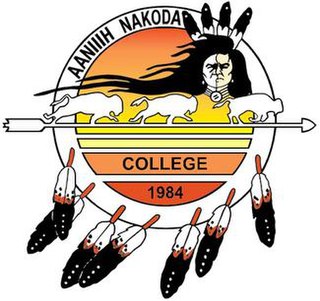
Aaniiih Nakoda College is a public tribal land-grant community college on the Fort Belknap Indian Reservation in Harlem, Montana. The institution incorporates native culture into the curriculum and promotes cultural identity; however, the school is open to both tribal and non-tribal members. Aaniiih Nakoda College is a member of the American Indian Higher Education Consortium (AIHEC), which is a community of tribally and federally chartered institutions working to strengthen tribal nations and make a lasting difference in the lives of American Indians and Alaska Natives. ANC was created in response to the higher education needs of American Indians. ANC generally serves geographically isolated populations that have no other means accessing education beyond the high school level.
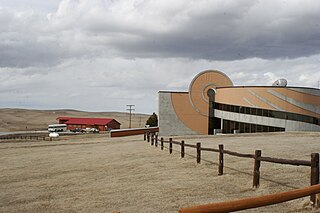
Oglala Lakota College (OLC) is a public tribal land-grant community college in Kyle, South Dakota. It enrolls 1,456 students enrolled part- and full-time. OLC serves the Pine Ridge Indian Reservation, which has a population of about 26,000 and covers 3,468 square miles in southwestern South Dakota.

Maskwacis Cultural College (MCC) is a private post-secondary institution within the Four Nations of Maskwacis, Alberta, Canada. MCC offers programs from basic adult literacy, two-year college diplomas, to university transfer programs.
Cheyenne Autumn Trail is a 19-minute live action American film produced in color for distribution in late 1964, with narration by James Stewart. Structured as a complementary social and historical companion piece to John Ford's final western, Cheyenne Autumn, it intersperses clips from the big-screen epic with background information about the Northern Cheyenne Exodus of 1878–79 and contrasts it with life on the Cheyenne reservation in 1964, as a tribal chief, a tribal beauty queen and a tribal adolescent take a drive along the route of the 19th-century trek.
Brookney Beaverheart Claire Boston Gondara is an American academic administrator, activist, and advocate for women and minorities in higher education. She is associate dean of professional studies and education at Santa Fe Community College. Gondara served as president of Iḷisaġvik College, the only tribal college in Alaska, from 2010 to 2011.
Rynalea Whiteman Pena is an American politician and tribal leader. She served as a member of the Montana House of Representatives from the 41st district. Elected in November 2020, she assumed office on January 4, 2021.
Marie Elena Brady Sanchez, was an American Cheyenne, Chief Judge of the Northern Cheyenne Tribe, a human rights activist for indigenous people and a linguist.
